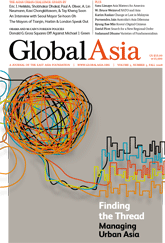The Fall 2008 issue of Global Asia focuses on "managing urban Asia." Eric Heikkila, professor of policy, planning, and development at USC, wrote the lead-off article, "Bird’s Eye View: Cities in East and Southeast Asia." Prof. Heikkila directs international initiatives at the USC School of Policy, Planning, and Development and is a member of the U.S.-China Institute's executive committee. Prof. Heikkila notes the rapid expansion of Asia's cities and discusses national and international hierarchies of cities and their discreet functions.
The article begins:
One makes sweeping generalizations only at one’s peril, and this can be no less forcefully true when describing Asian cities. Within the Asia Pacific region the variation one finds is breathtaking, and descriptions that might give us insights into Jakarta or Tokyo may have little traction when applied to Shanghai or Singapore. Nonetheless, it is possible to set out in broad brush details the nature of the aggregate collective. This task is somewhat analogous to the challenge of describing the attendees of a family reunion, where each individual is unique, yet the group as a whole may nonetheless be distinctive from other families. One can characterize the range or extent of its members while also conveying a sense of their relationships to one another. It is in this spirit that I undertake to provide here a bird’s eye view of cities in East and Southeast Asia.
.... [D]ata indicate that just under half of all people currently residing in East and Southeast Asia live in urbanized areas. Thus, this part of the world lags somewhat behind the global average, which has already surpassed the halfway point between urban and rural. Nonetheless, the present-day urban status in East and Southeast Asia represents a dramatic increase from 1980, when only one quarter of the population was urbanized. This trend is projected to continue, with over three-fifths of the region’s population urbanized by the year 2030….
One thing that these tables [showing the largest 50 cities] are not able to show is the relationship between cities. Size is not everything. Some smaller cities clearly “punch above their weight,” while some large cities pack relatively little punch. One important factor is economic strength. Jakarta may be three times the size of Singapore, but the latter exerts a greater presence in the economic sphere. Cultural and political dimensions are also important in situating cities within a larger purview, so that a city such as Suzhou in China or Phnom Penh in Cambodia — neither of which is included in this list of the top fifty cities — may be more significant in some sense than many cities that outrank them on the basis of population size alone.
You can read the entire article at the Global Asia website. Click here to download a pdf version.




